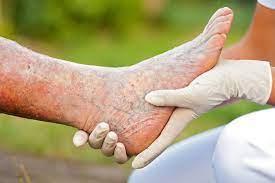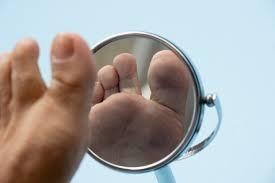The diabetic foot is a term that refers to the foot-related complications that can arise in individuals with diabetes. Diabetes can affect the nerves, blood vessels, and immune system, which can lead to a range of foot problems. Proper foot care is essential for preventing and managing these complications. Here’s a detailed discussion on the diabetic foot:
Impact of Diabetes on Foot Health:
- Peripheral Neuropathy: High blood sugar levels can damage nerves, leading to peripheral neuropathy. This reduces sensation in the feet, making it difficult to detect injuries, blisters, or wounds.
- Reduced Blood Flow: Diabetes can damage blood vessels, causing reduced circulation to the feet. Poor blood flow impairs the body’s ability to heal and fight infections.
- Immune System Impairment: Diabetes weakens the immune system, making it harder to fight infections. Even minor injuries can lead to serious infections in individuals with diabetes.
- Changes in Foot Structure: Diabetes can alter the structure of the feet, leading to deformities like bunions, hammertoes, and Charcot foot (a condition where the bones in the foot weaken and fracture).
- Dry Skin and Calluses: High blood sugar levels can lead to dry skin, which increases the risk of cracking and callus formation.
- Ulcers: Due to reduced sensation and compromised healing, even small cuts or blisters can turn into ulcers that are slow to heal.
- Foot Amputation: If foot ulcers or infections are left untreated, they can progress to a severe stage that may require amputation.
Diabetic Foot Care:
- Daily Foot Inspection: Check your feet every day for any signs of blisters, cuts, redness, swelling, or changes in color. Use a mirror if necessary to see all areas of your feet.
- Proper Hygiene: Wash your feet daily with lukewarm water and mild soap. Gently dry your feet, especially between the toes.
- Moisturize: Apply a moisturizer to keep your skin hydrated. Avoid applying moisturizer between the toes.
- Trim Nails Safely: Trim your toenails straight across and avoid cutting them too short. If you have reduced sensation, seek professional help for nail trimming.
- Diabetic Shoes: Wear well-fitting, comfortable shoes that provide adequate support. Diabetic shoes with extra depth and cushioning can help reduce pressure on the feet.
- Avoid Going Barefoot: Protect your feet by wearing shoes or slippers even when indoors.
- Regular Exercise: Engage in regular low-impact exercise to improve circulation and maintain foot flexibility.
- Blood Sugar Control: Keep your blood sugar levels under control to prevent complications and improve overall health.
- Regular Checkups: Schedule regular visits to a podiatrist who specializes in diabetic foot care. A podiatrist can assess your foot health, provide education, and address any issues.
- Foot Ulcer Prevention: Avoid using heating pads, hot water bottles, and direct heat on your feet. Use caution with foot soaks, and never attempt to remove calluses or corns yourself.
- Foot Elevation: Elevate your feet whenever possible to improve blood flow and reduce swelling.
- Footwear Assessment: Have a podiatrist assess your footwear for proper fit and support.
When to Seek Medical Attention:
- If you notice any cuts, sores, or blisters that are not healing.
- If you develop an infection or see signs of infection, such as redness, warmth, swelling, or pus.
- If you experience unusual pain or changes in sensation.
In Summary: The diabetic foot requires diligent care and attention due to the increased risk of complications. By practicing proper foot hygiene, wearing appropriate footwear, and seeking regular podiatric care, individuals with diabetes can significantly reduce the risk of foot-related issues, ulcers, and amputations. Effective management of diabetes, combined with proper foot care, can contribute to overall well-being and a better quality of life.
Share this post:





